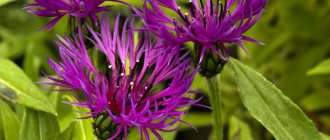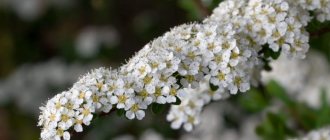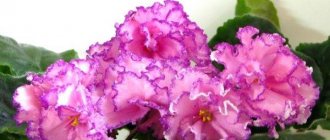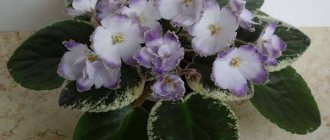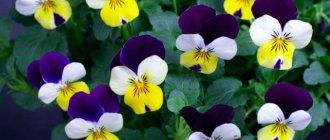Saintpaulia is better known among people as Uzambara violet. Uzambaros (South Africa) is the place of origin of the variety, and the houseplant is called violet because of its similarity to a garden flower with the same name. Today we will present to you some varieties of violets with descriptions, photos and names, and also tell you about growing and caring for this indoor plant.
Varieties of indoor violets 2. Propagation of Saintpaulia 3. Lighting Saintpaulia 4. Watering and bathing Uzambara violets 4.1 Wick watering 4.2 Watering in a tray 4.3 Watering under the leaves 4.4 How to bathe Saintpaulia 5. Caring for violets 5.1 Which soil to choose 5.2 Optimal temperature for growing 5.3 Pot for violets
Photo: Saintpaulia is the correct name for indoor violet.
Name of Saintpaulia varieties
The plant was named Saintpaulia in honor of its discoverer, the German Baron Ulrich von Saint-Paul. Despite the external similarity of the Uzambara violet to a garden flower, the plants have little in common: the second belongs to the violet family, and the first to the Gesneriaceae family. They also have different methods of reproduction and cultivation.
| Interesting. In nature, yellow Saintpaulia does not exist. |
Selection does not stand still. Today you can collect a collection of indoor violets of various colors: white, pink and even yellow. Today there are more than 20 thousand registered species alone. Below we have presented a description of some varieties of Saintpaulia.
Violet VaT-Dark Lady
The plant of this variety has a fairly large rosette, reaching up to 35 cm in diameter. It has beautiful variegated leaves and double large purple flowers, sometimes with pink dashes.
Photo: Saintpaulia “Dark Lady”.
Violet Dn-Royal Star
The violet variety has large flowers with “fantasy” pink polka dots.
Photo: Dn-Royal Star variety.
TS-Fairy's Gift
An exclusive variety – chimera. This means that a contrasting stripe of some color runs along the petals or flowers of the plant. Its peculiarity is that it reproduces only by stepsons from a peduncle or from shoots. Due to a combination of genes, the chimera cannot reproduce by leaf, like other varieties of violets.
Photo: chimera violet “Fairy’s Gift”.
NK-French Boulevard
Saintpaulia of this variety has an interesting color with white spots and a green border, which does not disappear with temperature changes, which often happens with other varieties of violets.
Photo: violet “French Boulevard”.
LE-Vanilla Parfait
This variety is interesting for its milky color of flowers and yellow impregnation, which is not often found in violets. It is very difficult to breed yellow Saintpaulia.
Photo: “Vanilla Parfait” variety.
Le-Brilliant Tiffany
This is an almost entirely yellow violet. The white color extends only along the edges of the petals. The green border sets off the yellow color and gives it a more saturated shade.
Photo: yellow Saintpaulia "Tiffany Diamond".
LF-Tenderness of the Princess
The variety is interesting in the form of flowers with a ruffled ruffle. The color of the plants varies from completely pink with a white border to white.
Photo: Saintpaulia variety “Tenderness of the Princess”.
Violet ND-First-grader (N. Danilova-Suvorova)
Author of the variety
The spectacular violet of the most delicate color “ND-Pervoklaska” is the result of the research of Natalya Danilova-Suvorova , a St. Petersburg breeder with a fairly well-known name in the violet growing community.
It has an extensive line of varieties with the branded prefix “ND”. Many master Saintpaulias are popular not only among Russian, but also among foreign flower growers.
Taxonomy
According to the scientific taxonomic classification, “ND-Pervoklaska” is a variegated variety belonging to the genus Saintpaulia of the Gesneriev family.
The violet, due to the characteristics of the leaf rosette, is described as a standard type , the filling of the corolla with petals indicates that it belongs to the double species , and in terms of the color of the flowers it is a fantasy group .
Photo and description of appearance
The variety forms a magnificent exhibition rosette of leaves with a leveled contour, symmetrical configuration, dense filling and tiled arrangement of leaves in tiers according to the mosaic principle.
The color of the leaf blades allows us to classify the violet as a variegated group of the bordering species. The leaves of varietal specimens are distinguished by a rounded heart-shaped shape, a light venation pattern, a smooth shiny surface, finely notched serration of the lateral edges and a wavy edge structure.
The leaves are painted in the tone of summer green with a contour of light yellow interrupted lines, strokes and dots.
Remarkable! A distinctive feature of the variety is the soft structure of the leaves - reduced fragility, which is convenient for transporting and carrying the plant.
Flowering occurs in a cap type with the formation of a large number of large, terry-filled corollas. The volume of each flower is greatly increased due to the layering, frilled structure and fringe of the petals.
The corollas are painted white with pinkish prints randomly scattered across the petals, which tend to change the color intensity and location on the petals during subsequent flowering. The entire pink surface of the flowers is splashed with fantasy patterns of stripes and specks of purple.
The variety is able to bloom almost without a break for rest.
Sports
Saintpaulia "ND-Pervoklaska" is occasionally able to bloom with sport without the appearance of fancy mottling . Sports can be of different types of color:
- white corollas with low-intensity lilac-colored imprints;
- or with a significant degree of lilac spots;
- pink spots of varying tone intensity without fantasy.
In sports, only the color of the corolla changes , the rest of the plant remains unchanged.
How to propagate violets
Violets reproduce by leaf. The colors of solid varieties will be transmitted with a 99% probability. If Saintpaulia flowers have a bright multi-colored color, border or multicolor, they may not bloom according to the variety. This is called flowering sport. That is, the color of the petals will differ for each plant obtained during the propagation process.
Photo: violet propagation by leaf.
The greatest likelihood of passing on parental characteristics is provided by rearing from stepchildren. Stepchildren are small rosettes that grow between the leaves.
Sometimes violets are propagated by flower stalks. Their bracts also give a 99% chance of transmitting traits. In this case, the peduncle itself is planted, but its flowers are torn off, leaving a small stump. The petiole is broken off and used as planting material. Small Saintpaulias will grow in the axils between the bract and the stem.
Photo: new Saintpaulias will grow from this small part of the flower plant.
Features of flowering, growth and reproduction
The plant develops at an average pace . In order to get a full-fledged plant, you should wait from 10 to 12 months, but this often depends on the conditions.
Propagated by leaves, lateral shoots and peduncles. He often goes into sports. Genetic mutations appear as a deep lilac or purple color instead of white.
It blooms well even in hot weather, but it may darken. For this reason, it is better to keep the outlet cool .
It doesn't bloom for very long . It stays fresh for two to three weeks and then begins to fade.
Peduncles are low, strong, erect. Almost always blooms with a beautiful cap.
Lighting violets
Uzambara violets require good lighting: 8-10 hours of high-quality light. Therefore, in winter it is necessary to grow them on a window with additional lighting with a certain number of lumens.
With comfortable lighting, Saintpaulias grow with an even flat rosette and good strong peduncles. If the plant does not have enough light, the leaves will begin to stretch upward. This affects the shape of the rosette and peduncles. They will not be able to grow stronger and develop properly; they will lie down on the rosette.
And in the summer, Saintpaulia on the windowsill can receive an excess of light. For comfortable development, it must be protected from direct sunlight with roller blinds or tulle that diffuses light. Eastern windows are best suited for violets, but even on them it is recommended to shade the flowers in the morning.
Photo: in good light, violets grow lush with a flat rosette and large peduncles.
Violets in November: WaT-Lilu, White Pearl, Cinnamon Rose and other varieties of violets.
Good day, dear like-minded people! After a long break, I decided to show some of my beauties, which have recovered from a long hot summer and are now beginning to bloom en masse. Window sill in the kitchen in early October, the sun no longer “bites”, the leaves have begun to even out:
And this is a month later:
In the center is a huge bouquet of Evening Splandor (Sorano), this is the official sport from Arctic Frost, although it differs from it in the larger size of the rosette. At the end of flowering, white splashes appeared on some flowers, revealing the origin of the variety:
The flowers on it lasted an incredibly long time - from the beginning of August until mid-November, unfortunately, the rosette became sick, and now the variety will have to be found through friends, since not a single leaf survived. But such beauty is worth another couple of years of adaptation after being in other conditions:
N-Gossamer was pleasantly pleased by returning to the varietal color; in the summer I already showed it, it bloomed almost white:
These flowers hung until the beginning of November (each flower of this variety lasts at least a month even in the wild heat), and after that new flower stalks began to open bright pink bells, and now the rosette looks like this:
I have already told you more than once that I grow Winter Parasol (Sorano) from the leaf; almost always the variety is repeated with different variations. I love it for its friendly, frequent flowering, “long-lasting” flowers and compact rosette. You can often see the following picture on this variety:
All flowers are colored differently
On one of the peduncles they are like those of Iceberg, which can also grow from a Winter Parasol leaf. But Iceberg always grows larger, and the flowers on it fade 2 times faster, here are 2 varieties side by side:
Now a little about my new arrivals; this year they are blooming slowly and not together. I don’t remember if I showed RM-Tsarina Sheba (Skornyakova), I just can’t make up my mind about this variety: buyers at exhibitions are very attracted by the bright colors of the flowers, but they themselves are not very large on long peduncles, the color fades slightly over time. The rosette is ideally shaped, but rather spreading, about 35 cm:
After a month the outlet looks like this:
But we must give her credit - the flowers are the same, she removed only one peduncle, which was the first to open in early September. Closer flowers:
WaT-Lilu (Valkova) was also not pleased with the miniature rosette, beautiful variegated leaves on such long cuttings that in a narrow space they begin to literally “rakes in” the light, like rowers with oars, attempts to break off the rosette, to make it smaller only spoil the appearance of this variety for normal development you need at least 40 cm of free space:
The flowers are very bright, cheerful, but the fallout, fortunately, lasts a long time, and the flower stalks constantly grow:
The White Pearl (Shcherbakov) trailer bloomed quite happily:
The flowers are not large and not very durable, but the plant is still very young, maybe over time they will be more stable, it’s good that there are whole clusters of these “pearls” on each peduncle:
I was especially pleased with the Cinnamon Rose (Morev), I took the leaf last fall, there were a lot of children, but the rosette grew slowly and took a very long time to bloom. Leaves on long cuttings strive to hug the pot:
But the peduncles are strong, erect, and the large buds turn into luxurious bright coral flowers with a dark cherry speckled edging along the edges of the wavy petals, and this happens literally before our eyes, here they are 2 days ago:
And this is today:
Before continuing the show, a small lyrical digression. Early winter has also come to us, usually at this time full-fledged leaf fall is just beginning, the forests are still full of honey mushrooms, but this year something went wrong, and literally within a day we were covered with snow, and then also caught with frost. Here are a few sketches of a frosty morning:
And the lush African spring begins on the flower racks:
I have already shown all the other varieties more than once, so I won’t go into too much detail about them, it’s just that this year I didn’t bother my charges much, and they responded gratefully to my care. Blue Fog (Morev)
Rondita:
Rose Garden (E.Champion) semi-mini, 9 rosettes grow in a 9-piece, half filled with drainage. Because of the long falling flower stalks, I keep it in a tall vase. The stems elongate very slightly, about 5-7 cm per year, so it’s a stretch to call this variety a trailer, although I bought it as a trailer.
Apache Skybird (J.Munk)
Golden Autumn (Sorano):
AN-Belye Nalivy (Andreeva)
Partly Cloudy (J.Boone)
LE-Kupava (Lebetskaya):
My trailers: 23-River Severka (this rosette is worth paying attention to, it has been blooming almost continuously for more than 4 years, during which time I have replanted it several times, the stem has almost formed a ring around the edge of the pot).
2 chimeras - mini and maxi, although Lyon's Fortuna Teller (Sorano) I broke off the leaves to at least slightly reduce the size of the rosette, and the mini - Rob's Kid Wheezy (R. Robinson)
Thank you for your attention! I'll try to show up more often now.
How to properly water and bathe Saintpaulia
Watering indoor violets is carried out using different methods.
Wick watering
You can organize wick watering: a small glass with a plant is placed in a larger diameter container with a nutrient solution, into which a string is inserted from below. With its help, moisture enters the soil.
The nutrient solution for wick irrigation consists of water and fertilizer. But for this method of watering, 5-7 times less fertilizer is added than indicated in the instructions for it. This method also requires soil of a special composition: clean high-moor peat and a large amount of rippers. Perlite or foam balls are suitable as rippers.
Photo: wick watering of Uzambara violet.
Watering into a tray
It is carried out by growing Saintpaulia in a pot with a special tray into which water will be poured. It is important that it does not stagnate in the pan. So if, after a while after watering, the water does not leave the pan, it must be drained. Otherwise, rotting of the root system may occur, as a result of which the rosette may die.
When watering in the tray and under the leaves, use a purchased universal substrate. It is not recommended to use soils intended specifically for violets: it will be difficult for the delicate roots of plants to get used to them.
Watering under the leaves of the plant
It is done very carefully along the edge of the outlet or at its base. You should not pour water into the center of the outlet: the sheets there are very fragile and delicate. Moisture can damage them.
How to bathe a violet
Saintpaulias can be sprayed and bathed during the period of active growth of young plants. You should not bathe them more than once every six months.
After bathing, the flower must be protected from light, allowing it to dry in a dark place. Drops of water remaining on the sheets, combined with light, can work like a magnifying glass and burn the plant.
Photo: Saintpaulia bathing.
Reviews
Veronica Ignatievna. “I saw the “ND-Pervoklaska” violet at the exhibition - it blew my mind: huge white and pink pompoms with chic frills on each petal, and even purple patterns on a pink field and variegated foliage. I don’t know what this variety looks more like: a blooming white lilac, a debutante’s ball gown, a student’s bows, or an airy cake with whipped cream. There are no more leaves left for sale, I’ve added the variety to my wish list.”
Yana. “The master turned out an excellent variety “ND-Pervoklaska”, I fell in love at first sight! Everything I like: huge flowers, pompousness, flounces, and a rosette of variegated leaves. And the fact that the brightness of the buds can be changed by temperature is absolutely super! I bought two leaves - for myself and my sister. I hope he doesn’t go into sports.”
Growing and caring for violets
If the rosettes do not bloom, they are watered with fertilizers with a high nitrogen content so that the violet grows leaf mass. When it gets ready to bloom, you can water it with potassium fertilizer. This will increase the number of peduncles and the quality of flowering. For everyday feeding, use any universal fertilizer for flowering plants.
| On a note. Liquid fertilizers are more convenient to dilute and dose than dry ones. |
Soil for Saintpaulia
The soil should be chosen to be breathable, initially loose or with a large number of rippers. This is necessary so that the violet roots receive enough oxygen. The plant should be aerated constantly, and the water should not stagnate.
Temperature for growing violets
Optimal temperature for growing Saintpaulias: 20-24 degrees. At temperatures below normal, the rosette becomes overcooled, and in extreme heat, plant growth slows down, increasing the risk of developing fungal diseases.
To prevent spots from appearing on the leaves of the plant, it should be protected from drafts. In winter, the ingress of cold air onto violets is minimized by insulating them with a heat insulator or moving them away from windows during ventilation. Photo: violet should be grown in certain temperature conditions.
Care instructions
Because these crops are very delicate, they require more attention.
I want to share some useful tips:
- When watering from the air, make sure that water does not fall on the leaves and flowers;
- There is no need to spray the plants. To hydrate, simply place a cup of water next to it;
- do not expect the desired color at the first flowering;
- maintain optimal temperature. Remember that the yellow pigment only appears at 18 degrees Celsius. As the temperature rises, the richness of the yellow tint disappears;
- violets need soft, diffused light;
- when feeding yellow varieties of violets, it is recommended to reduce the dose by half than required in the instructions.
Rules for planting roses Polka
In order for flower growing to be successful, you should read the description and step-by-step planting instructions.
- a hole is dug measuring half a meter in width and length, and 12 cm in depth;
- half a bucket of manure is placed at the bottom and left for a day;
- manure and soil are thoroughly mixed and the hole is completely filled, making a small mound;
- a seedling is planted on top of the hill, the roots of which are carefully leveled;
- the root system is completely covered with soil;
- The planted flower must finally be watered and spudded abundantly;
- 15 cm of the stem is left above the ground surface, the rest is removed;
- the root zone is mulched with a layer of peat or humus.
Deadlines
The climbing rose Polka is planted in the spring: at the end of April or the first half of May. In the south, work is carried out in the fall, before the cold sets in. 3 - 4 weeks before frost, seedlings will be able to adapt to new conditions.
Advice! If a seedling is purchased in the fall, and the planting time has passed, then it is buried in the ground, covered with sawdust or dry leaves until spring.
Site selection and soil preparation
For the climbing hybrid Polka, choose a sunny area that is well lit in the first half of the day. The place should be well ventilated, but not exposed to cold wind. The best option for a climbing plant is walls and supports on the southwest and south sides. The permissible groundwater level should be no higher than 1 m.
Application in landscape design
If a rose is properly cared for, it can grow and smell fragrant for fifty years. Lush flowers and branches that can curl high will decorate houses and gazebos. Look great in arch shape. Most often the flower is used as a hedge.
To create a flower arrangement in a flower bed, it is recommended to plant a climbing rose in the center. This way the rest of the plants will highlight the delicate flowers. It is not recommended to plant Polka next to plants with bright flowers.
Important! The Polka rose bush looks beautiful as a hedge.
Violet Pink watercolor: reproduction
Violet Pink watercolor: photo of the variety
Cuttings.
The cuttings are violet leaves. Propagation should be made from cut lower healthy leaves. After trimming, the most beautiful leaves are selected, they are placed in a container with water, one drop of hydrogen peroxide and an activated carbon tablet are added to it in advance.
The water changes periodically and you should wait until the roots appear. After their formation, the cuttings are planted in the soil. It is prepared as for adult vegetation. The containers are taken small, five cm in diameter and in height.
Dividing the bush.
This procedure is carried out during replanting if the flower has produced side children - these are small bushes containing several leaves that grow from the ground. After the flower is pulled out of the ground, it is carefully divided by hand; this is not difficult.
If the roots are strongly intertwined, you can use scissors that have been treated with alcohol. Young plants are planted in small pots. Cover with film for 24 hours to create greenhouse conditions.
Diseases and pests
Rosa Polka can be affected by the following diseases:
- gray rot;
- bark burn;
- bacterial cancer.
It is impossible to save a plant from cancer. The only method to combat this disease is proper care and prevention.
The most dangerous flower pests are aphids and garden ants. To combat them, gardeners use insecticides.
To make the garden beautiful and unique, climbing roses are suitable. The Polka rose will especially delight you with its fragrance. It not only produces a large number of delicate flowers, but also fills the garden with a unique aroma.
Protection
Rose variety Polka has average immunity to powdery mildew. The disease appears as white spots that spread quickly in hot and humid weather. The development of the bush slows down, which negatively affects its flowering and decorativeness. To combat and prevent powdery mildew, the rose is sprayed with Bordeaux mixture.
Another dangerous disease of climbing roses is koniothyrium, or bark cancer. It is diagnosed in the spring after the cover is removed. Reddish spots appear on the bark, which increase in size and turn black. The lesion spreads in high humidity. Affected shoots are cut off and burned. To prevent cancer, roses are fed with phosphorus compounds, cover is removed when the weather gets warmer, and nitrogen fertilizing is abandoned in the fall.
Climbing roses are susceptible to attack by aphids and spider mites. Insecticides such as Iskra, Karbofos, Actellik help get rid of pests. Folk remedies include wood ash and onion peel infusion.
Display of life phases
The course of life processes in its main direction converges with the manifestations of similar life phases of most varieties of the genus.
This makes it possible for novice collectors of tropical beauties to calculate schedules and regimes for caring for violets using a standard pattern with minor allowances for nuances.
Specificity of room development
Experienced flower growers consider the violet variety to be ideal for maintaining indoor culture in the microclimate ; it is especially suitable for beginners in the “Saint Paul” hobby as the first specimen of an exotic collection thanks to:
- Resistance to adverse events and endurance in case of minor maintenance violations;
- Easy care techniques;
- Simple methods of reproduction and an abundance of children;
- Lush and decorative flowering.
CAREFULLY! The variety reacts negatively to any removal of leaf blades in large quantities, whether for propagation purposes or for sale and distribution among gardeners. A varietal plant in such a situation may change its flowering time or simply abandon this important life phase at a particular stage.
When cultivating violets indoors, special attention should be paid to watering regimes , in particular to the amount of water the plant receives. This will prevent parts of Saintpaulia from rotting due to the accumulation of liquid in the flowerpot, to which the variety is largely susceptible.
During the process of forming a rosette, the leaves of a specimen can often curl down, trying to hug the flowerpot, which :
- Contradicts the author's description of the variety;
- And it spoils the decorative impression of the violet.
A rosette corset can help cope with this negative phenomenon .
Education of an adult specimen
The onset of the phase of the first flowering and maturation of the violet occurs with the leaf petioles method approximately eight months after the formation of the rudiments of the children . If a violet specimen is obtained from an axillary shoot from an adult plant, then the period of maturation will be noticeably reduced.
Peculiarity of reproduction
The process of vegetative propagation of varietal violets almost completely copies this life phase in most varieties of Saintpaulia - to obtain young specimens, flower growers have only two methods :
- By carefully separating the stepsons that have grown on it from an adult violet , and rooting them in due time in their own flowerpots;
- Having formed a baby on a leaf petiole , specially prepared for this purpose, followed by rooting.
ADVICE! You should not use seed propagation to produce young violets. Any attempts in this area are fraught with partial loss of varietal characteristics or complete loss of the variety.
The method of mandatory rejuvenation of adult violets ensures that all the characteristics of the variety remain intact.
The violet does not like it when almost all the leaves are removed from it for the suffering - after such a barbaric procedure, Saintpaulia becomes very sick and has difficulty recovering.
Effect of temperature on flowers
Blooming violets exhibit a certain dependence on changes in temperature indicators:
- When flowering in cool conditions, the intensity of the pink color of the flowers is lower, the longer the exposure to low temperatures occurs - the color can turn into a completely white color;
- The higher the temperature in the room with a violet in bloom, the brighter its flowers will be;
- A decrease in the temperature in the room leads to a change in the size of the flower: the colder it is, the larger the diameter of the flower;
- Low temperatures bring out the brightness of the edge band of the petals.
Varietal violets must be protected from changes and sudden changes in temperature, as well as from drafts.
ATTENTION! These factors contribute to flower drop and flowering delay or failure.
Pedicel structure
The variety immediately has strong, optimally sized peduncles that easily support heavy flower caps in a straight position, preventing them from spreading out on the leaf plates of the rosette.
Flowering type model
At first, the variety blooms with single flowers , but gradually gains strength and forms lush caps.
The violet will be grateful for a little help in preparing for powerful cap blooms - just remove the first buds before they dissolve.
Lifespan of an individual flower
Saintpaulia Pink Watercolor blooms for almost 1.5 months.
During flowering, a violet can maintain freshness and general decorativeness for a long time , while each individual corolla can live up to five weeks.

